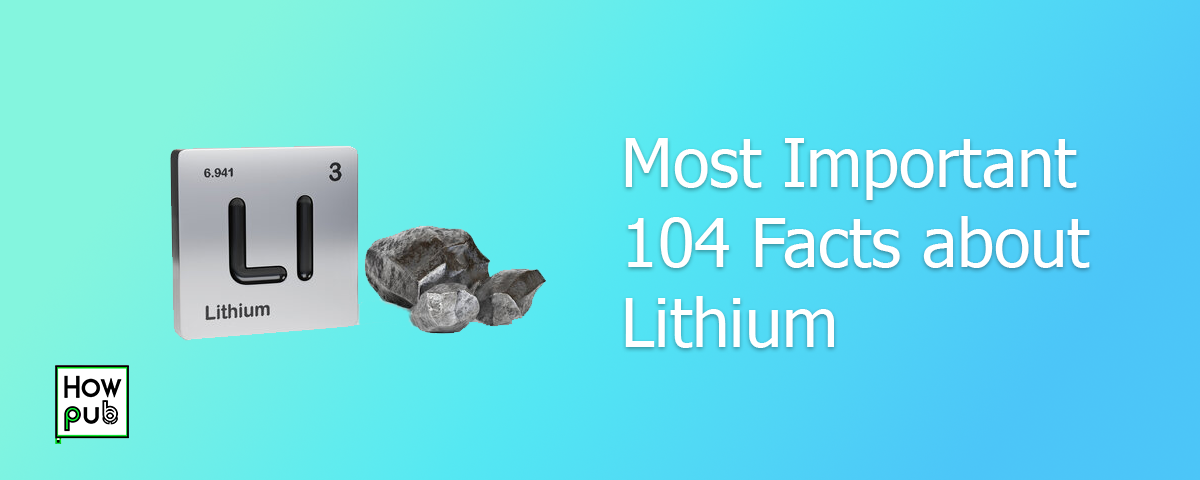Introduction
As I am passionate about multiple topics, lithium is one of them, and I will try to answer as many questions as I can in this article. I have learned many things over the years that have passed, and now I will share them with you.
1. General Lithium Information
Let's jump into some general questions and answers regarding lithium.
- Can you bring lithium-ion batteries on a plane?
- Yes, you can bring lithium-ion batteries on a plane, but they must be carried in carry-on baggage, not checked luggage.
- Lithium compounds
- Common lithium compounds include lithium carbonate, lithium chloride, and lithium hydroxide, used in various applications from medication to battery production.
- Is lithium a metal, metalloid, or nonmetal
- Lithium is a metal, specifically classified as an alkali metal.
- Where to get lithium
- Lithium can be obtained from mining companies, chemical suppliers, and manufacturers of batteries and electronic components.
- Lithium oxide chemical formula
- The chemical formula for lithium oxide is Li2O.
- Lithium hydroxide molar mass
- The molar mass of lithium hydroxide (LiOH) is approximately 23.95 g/mol.
- Which is the electron configuration for lithium
- The electron configuration of lithium is 1s^2 2s^1.
- White lithium grease vs silicone
- White lithium grease is better for metal-to-metal contact, whereas silicone grease is preferred for high-temperature and rubber components.
- Lithium bicarbonate formula
- The formula for lithium bicarbonate would be LiHCO3.
- Lithium Subnautica below zero
- In the game Subnautica: Below Zero, lithium is a resource used to craft various tools and building materials.
- Emission spectra for lithium
- The emission spectrum of lithium includes lines primarily in the red and far-red parts of the visible spectrum, useful for analytical purposes.
- Lithium bromide molar mass
- The molar mass of lithium bromide (LiBr) is about 86.85 g/mol.
- Flame color of lithium chloride
- Lithium chloride produces a deep red flame when burned, useful for pyrotechnics and flame tests.
- Lithium electron affinity
- Lithium has a relatively low electron affinity compared to other metals, meaning it does not readily gain electrons.
- Why can't you bring lithium batteries on a plane
- Due to the risk of fire from thermal runaway, airlines restrict passengers from bringing loose lithium batteries in checked luggage.
- Atoms in lithium
- A lithium atom consists of three protons, four neutrons, and three electrons, with a simple configuration in the alkali metal group.
- Potassium and lithium
- Potassium and lithium are both alkali metals with similar chemical properties, though potassium is less reactive.
- Lithium pronunciation
- Lithium is pronounced as LITH-ee-um.
- Lithium is solid liquid or gas
- Lithium is a solid at room temperature.
- Ion name for lithium
- The ion name for lithium is lithium ion, often represented as Li+.
- Lithium hydroxide monohydrate
- Lithium hydroxide monohydrate is used in various applications, including as a CO2 scrubber in breathing gas purification systems.
- Does a Kindle have a lithium battery
- Yes, Kindle devices are equipped with lithium-ion batteries.
- Lithium aluminium hydride structure
- Lithium aluminium hydride, LiAlH4, is a complex hydride, known for its use as a reducing agent in organic chemistry.
- Lithium chromate
- Lithium chromate acts as a corrosion inhibitor in industrial cooling systems.
- Lithium permanganate formula
- The chemical formula for lithium permanganate is LiMnO4.
- Lithium iodide molar mass
- The molar mass of lithium iodide (LiI) is approximately 133.85 g/mol.
- Lithium rocks
- Lithium can be found in mineral rocks such as spodumene and petalite, from which commercial lithium is extracted.
- Is lithium a cation or anion
- Lithium acts as a cation (Li+) in its ionic form.
- Lithium and nitrogen chemical formula
- The chemical formula for a compound of lithium and nitrogen is Li3N.
- Liquid wrench white lithium grease
- Liquid Wrench White Lithium Grease is used for lubricating moving parts such as gears, bearings, and slides, where moisture resistance is also needed.
- Calcium lithium
- Calcium and lithium are chemically different; calcium is an alkaline earth metal, while lithium is an alkali metal.
- Lithium nitrate molar mass
- The molar mass of lithium nitrate (LiNO3) is approximately 68.95 g/mol.
- How to extinguish a lithium battery fire
- To extinguish a lithium battery fire, use a Class D fire extinguisher designed for metal fires, not water.
- What foods contain lithium
- Foods containing lithium include cereals, potatoes, tomatoes, cabbage, and some mineral waters.
- Do AirTags have lithium batteries
- Yes, Apple's AirTags are powered by user-replaceable CR2032 lithium coin cells.
- Are laptop batteries lithium
- Most modern laptop batteries are lithium-ion, known for their rechargeability and efficiency.
- Do Apple watches have lithium batteries
- Yes, Apple Watches are equipped with lithium-ion batteries to provide reliable power and battery life.
- Lithium hydrogen sulfite
- Lithium hydrogen sulfite, or lithium bisulfite, is a compound that could be used in chemical synthesis or as a preservative.
- Lithium dichromate
- Lithium dichromate is a chemical compound used in various industrial applications, often as an oxidizing agent.
- What does raw lithium look like
- Raw lithium is a soft, silvery-white metal that is typically stored under oil to prevent it from reacting with air or moisture.
- Lithium chromate formula
- The chemical formula for lithium chromate is Li2CrO4.
- Lithium acetylide
- Lithium acetylide is a compound that can be used in organic synthesis as a source of the acetylide ion.
2. Lithium in Technology and Devices
Lithium also has a big impact on today's technologies and devices. I will cover topics like battery safety, regulatory performance, lifecycle, and alternatives.
- Disadvantages of lithium-ion batteries
- Disadvantages include vulnerability to overheating, degradation over time, and higher cost compared to other types of batteries.
- Shelf life of lithium-ion battery
- The shelf life of a lithium-ion battery depends on storage conditions but is generally around 2 to 3 years.
- How to jumpstart a dead lithium-ion battery
- Jumpstarting a dead lithium-ion battery involves using a charger that can apply a boost charge at a safe voltage to revive the battery.
- Can I charge a lithium battery with a normal charger
- It is not advisable to charge a lithium battery with a normal charger due to the risk of overcharging and potential damage; specific lithium-compatible chargers should be used.
- Lithium-ion battery not charging
- If a lithium-ion battery is not charging, it could be due to issues with the battery cell, charger, or the device's power management system.
- How to make a lithium-ion battery
- Making a lithium-ion battery involves assembling layers of anode, cathode, separator, and electrolyte, then sealing in a charge-retentive casing.
- 12V lithium battery voltage chart
- A voltage chart for a 12V lithium battery shows different states of charge from fully charged to discharged, indicating voltage levels for each state.
- Difference between lithium-ion and lithium polymer
- Lithium-ion batteries use a liquid electrolytic solution, while lithium polymer batteries use a polymer gel as the electrolyte, offering a slight safety advantage.
- Will lithium batteries freeze
- Lithium batteries can freeze under extreme cold conditions, which can lead to reduced efficiency or damage when recharged.
- How long can a lithium-ion battery last without charging
- A fully charged lithium-ion battery can last several months without charging if stored properly at a cool temperature.
- How to revive a lithium-ion battery
- Reviving a lithium-ion battery involves using a charger set to a low charging voltage to slowly replenish charge capacity.
- Disposal of lithium polymer batteries
- Lithium polymer batteries should be disposed of at a proper recycling facility due to risks associated with improper handling.
- Lithium tester
- A lithium battery tester is a device used to check the voltage and health of lithium batteries.
- Are alkaline batteries lithium
- Alkaline batteries are not lithium; they typically use zinc and manganese dioxide as their main components.
- Difference between LiPo and lithium-ion battery
- LiPo (lithium polymer) batteries use a solid polymer electrolyte, while lithium-ion batteries use a liquid electrolyte, affecting flexibility and form factor.
- H7 lithium battery
- An H7 lithium battery refers to a specific size and type of lithium battery used in automotive applications.
- Lithium iron phosphate vs lead-acid
- Lithium iron phosphate batteries offer a longer lifespan, better thermal stability, and higher efficiency than lead-acid batteries, albeit at a higher cost.
- Lithium ion battery charging voltage
- The typical charging voltage for lithium-ion batteries is around 4.2 volts per cell.
- 1 lithium polymer batteries required
- Devices stating "1 lithium polymer batteries required" indicate they need a single lithium polymer battery to operate.
- Lithium iron phosphate vs lead acid
- Lithium iron phosphate batteries are more efficient, have a longer lifespan, and are safer than lead-acid batteries, but they are also more expensive.
- What happens if you use alkaline batteries instead of lithium
- Using alkaline batteries instead of lithium can result in lower performance, as alkaline batteries have different voltage and discharge characteristics.
- How to store lithium-ion batteries when not in use
- Store lithium-ion batteries at a 50% charge in a cool, dry place to maximize their lifespan.
3. Medical and Biological Uses of Lithium
Lithium is also used in medicine, and in this area, I will discuss how you can use lithium to treat conditions, as well as what kind of side effects could appear and other health concerns.
- Lithium chloride MSDS
- Material Safety Data Sheets (MSDS) for lithium chloride include handling, storage, and hazard information, emphasizing its moisture sensitivity and irritation potential.
- Lithium carbonate extended-release
- Lithium carbonate extended-release tablets are used to treat bipolar disorder, providing a steady release of lithium to maintain stable blood levels.
- Lithium and OCD
- Lithium is sometimes used as an adjunct therapy for treating Obsessive-Compulsive Disorder (OCD), particularly when standard treatments are ineffective.
- Lithium hyponatremia
- Lithium can cause hyponatremia, a condition where sodium levels in the blood are abnormally low, as a side effect of its influence on kidney function.
- Lithium kidney
- Long-term lithium use can affect kidney function, potentially leading to chronic kidney disease.
- Can you take lithium while pregnant
- Lithium is generally not recommended during pregnancy due to the risk of congenital malformations, unless the benefits outweigh the risks.
- Lithium and salt intake
- Increased salt intake can decrease lithium levels in the body, requiring adjustments in dosage for those on lithium therapy.
- Lithium aluminium hydride
- Lithium aluminium hydride is a chemical reagent used primarily as a strong reducing agent in organic synthesis.
- Lithium and HCTZ
- Hydrochlorothiazide (HCTZ) can increase lithium levels in the blood, necessitating careful monitoring to avoid toxicity.
- Lithium carbonate ER
- Lithium carbonate extended-release (ER) is formulated to be taken less frequently while maintaining steady lithium levels in the blood.
- Lithium potassium
- Both lithium and potassium are alkali metals with similar properties, but lithium is lighter and reacts more vigorously.
- Lithium and nephrogenic diabetes insipidus
- Lithium can cause nephrogenic diabetes insipidus by impairing the kidney's ability to respond to antidiuretic hormone.
- Lithium dietary
- Dietary sources of lithium include grains, vegetables, mustards, and drinking water, but in trace amounts.
- Aspirin lithium
- Combining aspirin with lithium can increase lithium levels in the blood, potentially leading to toxicity.
- Lamotrigine vs lithium
- Lamotrigine is typically used for bipolar disorder maintenance, while lithium is used for acute manic episodes and long-term treatment of bipolar disorder.
- How often are lithium levels checked
- For patients on lithium therapy, levels are typically checked every few months or as clinically indicated.
- Prozac and lithium
- Prozac and lithium can be combined under careful medical supervision to treat co-occurring depression and bipolar disorder, respectively.
- Can you drink on lithium
- Drinking alcohol while on lithium is generally advised against, as it can increase the side effects of lithium and affect its blood levels.
- Wellbutrin and lithium
- Wellbutrin (bupropion) and lithium are sometimes used together in the treatment of bipolar disorder, but this combination should be managed by a healthcare provider.
- Abilify and lithium
- Abilify (aripiprazole) and lithium are often used together in the management of bipolar disorder to stabilize mood.
- Lithium headaches
- Lithium can cause headaches as a side effect, particularly when starting therapy or changing dosages.
- Lithium in breastfeeding
- Lithium is generally not recommended during breastfeeding due to the risk of it passing through breastmilk and affecting the baby.
- Lithium SIADH
- Lithium can cause or exacerbate Syndrome of Inappropriate Antidiuretic Hormone (SIADH), leading to hyponatremia.
- What painkillers can I take with lithium
- Nonsteroidal anti-inflammatory drugs (NSAIDs) should be used cautiously with lithium as they can increase lithium levels; acetaminophen is generally considered safe.
- Lithium teeth
- Lithium has not been directly linked to dental issues, but side effects like dry mouth from lithium treatment can increase the risk of dental decay.
- Lithium hypercalcemia
- Lithium can cause hypercalcemia, a condition where calcium levels in the blood are too high, often linked to its effects on the parathyroid glands.
- Lithium hyperthyroidism
- Lithium treatment can lead to hyperthyroidism by affecting thyroid function, requiring regular monitoring of thyroid hormone levels.
- Lithium alcohol withdrawal
- Lithium is not typically used for alcohol withdrawal directly, but it may be part of a treatment regimen for individuals with co-occurring bipolar disorder.
- Trazodone and lithium
- Trazodone and lithium may be used together to treat bipolar disorder, with trazodone providing additional antidepressant effects.
- Lithium and lamotrigine
- Lithium and lamotrigine can be used together in the treatment of bipolar disorder, with lamotrigine primarily addressing the depressive phases.
- Can lithium cause hallucinations
- While rare, high levels of lithium can lead to neurological effects, including hallucinations.
- Tardive dyskinesia lithium
- While lithium is not commonly associated with tardive dyskinesia, it can cause other neurological side effects.
- Does lithium cause tremors
- Tremors are a common side effect of lithium, especially at higher doses or when serum levels are at the upper end of the therapeutic range.
- Teratogenic effects of lithium
- Lithium has teratogenic effects, meaning it can cause birth defects, particularly if taken during the first trimester of pregnancy.
- Discontinuing lithium
- Discontinuing lithium should be done gradually under medical supervision to avoid withdrawal symptoms and prevent relapse of bipolar disorder.
4. Industrial and Economic Aspects
And let's not forget about the industrial and economic side of lithium, where I will cover matters such as lithium mining, environmental impact, lithium stocks and investments, and more related to the future of this magical element.
- Lithium-ion batteries settlement
- Settlements in lithium-ion batteries cases typically involve allegations of price fixing by manufacturers.
- Lithium trim cubes
- Lithium trim cubes refer to a specific form of lithium metal used in various industrial applications.
- ACME lithium stock
- ACME Lithium Inc. is a company involved in the exploration and development of lithium resources.
- Best lithium ETFs
- Top lithium ETFs include Global X Lithium & Battery Tech ETF (LIT) and Amplify Advanced Battery Metals and Materials ETF (BATT).
- Lithium Americas stock forecast 2030
- Lithium Americas Corp. is projected to benefit from the growing demand for lithium, potentially increasing its stock value by 2030.



